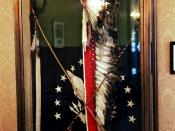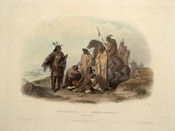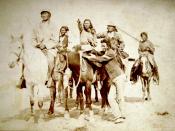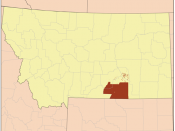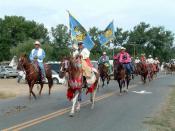Looking at the ethnohistoric sources of the Crow Indians can help construct the settlement and subsistence patterns of the prehistoric counterparts of the Crow.
According to one source, Joseph Medicine Crow's book From the Heart of the Crow Country, the reader is informed that when the Absarokee separated from the main tribe, believed to be the Hidatsa, they abandoned the ways of agriculture and went back to the nomadic ways of hunting and gathering. Because of the hunting they were always on the move and this lead to constant warfare with other tribes of the Plains and the mountains for prime locations (Medicine Crow 1992: 4).
As far as the social organization, the primary unit is the family, with the clan being the secondary unit. The clan is made up of distantly related families with membership based on matrilineal descent. This mens that a person belongs to his or her mother's clan, not the father's clan.
Then as the tribe population increased, it divided into sub-tribes or bands for the convenience and travel. These bands were governed by band chiefs which were supported and advised by a body of other chieftains. These band chiefs managed the affairs of important ceremonies and maintenance of law and order. The tribe of the Crow consisted of two main bands, the River Crow - who lived along the Missouri, Milk and Yellowstone Rivers - and the Mountain Crow - who enjoyed the life along the high ranges of northern Wyoming and southern Montana. There is a third group, called Kicked in the Bellies, and these are closely related to the Mountain Crow (Medicine Crow 1992: 5).
The economy of the Crow is based simply on the availability of game and the edible plants, and the tribes ability to find and procure them. In the Crow country, for both Mountain and River Crow, both game and plant food were abundant. Men were responsible for the hunting of game only, while the women cured the meat and also gathered roots and berried, and prepared them as supplies. Women were also responsible for the manufacture of clothes and household equipment, and they prepared the buffalo skins for the tipis (Medicine Crow 1992: 8).
As far as hunting goes, the main prey was buffalo, deer, elk, bighorn sheep, and some small game. The main type of hunting was the buffalo drive or buffalo jump. According to Medicine Crow, there are four main types of jumps. The first one is called the Classic type, which is characterized by a V-shaped line of stones, leading to the edge of the cliff (Illustration 1). This type of hunt involved only a few men to less than a dozen men to drive the prey off the cliff (Medicine Crow 1992: 91-93). The second type of jump is referred to as the Intermediate type. This is characterized by one line of rocks on one side, while the other side is lined with a natural barrier (Illustration 2). For this type of drive, the medicine man had some kind of role for making the drive successful, and the entire camp population was involved, making this the communal hunt. A few fast runners drove the animals, while the others would make a "human fence" along the rock line to scare and herd the animals off the cliff (Medicine Crow 1992: 93-94). The third type is the Natural drive. This uses the natural formation of a cliff that is formed by a peninsula with a point (Illustration 3). These are camouflaged by nature and used spontaneously as a group of hunters find a herd near such laces. These were never planned hunts, and the hunters on hand at the right moment would execute the drive whether afoot or on horseback (Medicine Crow 1992: 95). The fourth type is the Combination (Illustration 4), which can consist of two to three adjoining and interrelated sites. These are arranged in such a layout that one, two, or all three could be simultaneously put into operation. These multi-jump sites could be any combination of the other three types of jump (Medicine Crow 1992: 95-96).
Looking at Robert Lowie's The Crow Indians, we look at his findings. He sees the bands as being politically distinct, with chiefs forming the body of social leaders. This chief would decide when and where his followers were to pitch and to move their lodges, and he would appoint one of the military clubs to act as police. The foremost duty of this police group is to regulate the communal buffalo hunt (Lowie 1983: 5) Lowie also confirms the matrilineal descent of the Crow. The children of a family too their mother's clan name, and it included not only individuals related by blood through their mothers, but also unrelated folk reckoned as kin by a legal fiction. On the other hand, a man could never properly belong to the clan of his children, who were born into the their mother's group; and even if he adopted a child, it automatically fell into the clan of his real offspring, i.e. their mother's. With this Crow rule of descent, a child could belong to the father's clan only if its mother married a man of her own clan, a practice forbidden by the customary law of "exogamy" (Lowie 1983: 9).
The economy of the Crow, Lowie sees as primarily hunting ruminants. Fish are never mentioned, while berries and roots formed a regular part of the diet, but only as seasoning or dessert, and the corn that was traded for from the Hidatsa was for variety and not as a meat substitute. Men hunted individually or in small groups when going after deer at their watering places. However the communal hunt was far more important. Being mounted on horseback, the Crow could easily surround large herds and shoot the game. However, the buffalo drive of herds over the cliff were important, mainly because this type of tribal hunting sometimes yielded enormous quantities of meat (Lowie 1983: 72-73).
Not only did the women have to gather roots and berries, they also took care of the meat from the hunts. Since fresh meat was not always to be had, some of it was dried, prepared into pemican, and stored away in rawhide cases for future use. The women also took the hides and tanned them and prepared them for tipis, or sometimes offered her services to a neighbor who needed a new tipi cover that might pay her a horse (Lowie 1983: 75). The women may also be found spreading handfuls of chockcherries on a flat stone slab outdoors, pounding them and drawing out this mass into elongated confections to be dried in the sub (Lowie 1983: 84). The men not only were responsible for hunting, but also for the making of arrowheads, either of stone or bone. They also made up the specialists who would make the shafts and bows (Lowie 1983: 84-85).
The Crow Indian fit Hanson's classification for the band level of settlement and subsistence structure. The River and the Mountain Crow are both located by primary resources. The animal herds are not too far off, with groups making excursions for hunting that may keep them away for a few days. Tress were nearby, used for fuel, tipi construction, and bow and arrow construction. As for resources of the arrowheads, bone would come from the hunt, but no mention of lithic resources was made. The Crow were grouped together based on family ties, based mainly on matrilineal descent. There is also ties through the military groups that patrol band actions, such as the communal hunt.
